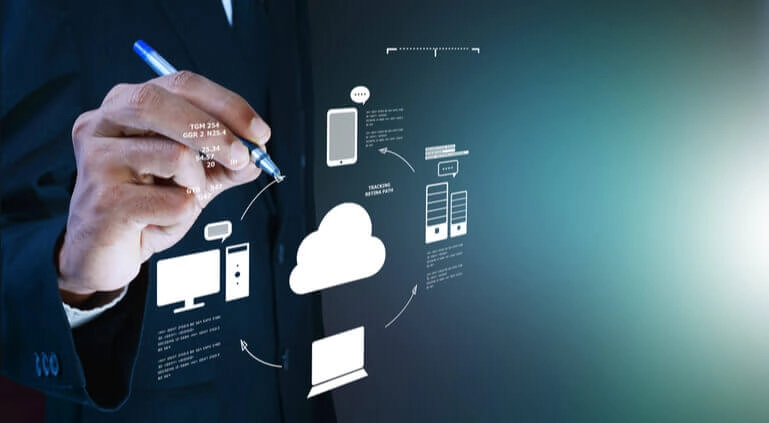Future of Cloud Computing: Trends & Innovations

Gain insights into the latest advancements and future trends in cloud computing, from edge computing to serverless architectures.
Even as cloud computing technology matures, research shows that cloud spending exhibits no signs of slowing down. 31% of most IT budgets are directed toward the cloud, and two-thirds of IT decision-makers expect cloud budgets to increase in the next 12 months. Read on to know what the future of cloud computing has to offer and how you can maximize it.
5 Emerging Trends Shaping the Future of Cloud Computing
As the future of cloud computing evolves, there are five trends we are seeing across industries, changing the paradigm of cloud consumption and delivery:
1. Serverless computing and Function-as-a-Service (FaaS)
Serverless computing, particularly through the Function-as-a-Service (FaaS) model, is revolutionizing the way applications are developed, deployed, and scaled. This trend abstracts the complexities of server management away from developers, allowing you to focus on writing code that serves your business logic without worrying about the underlying infrastructure.
In a serverless architecture, your applications dynamically scale and bill you only for the precise resources your code utilizes down to the millisecond, offering unprecedented cost-efficiency and scalability.
2. Hybrid and multi-cloud strategies
The future of cloud computing is neither public nor private but a blend of both, including on-premises resources—this is the essence of hybrid cloud strategies.
Furthermore, multi-cloud environments, where you leverage the best-of-breed services from multiple cloud providers, are becoming the norm.
This approach enhances your application’s resilience and availability and allows for strategic geographic distribution of services, compliance with local data regulations, and avoidance of vendor lock-in.
Adopting a hybrid or multi-cloud strategy requires sophisticated management tools that can abstract the complexity of operating across multiple platforms. This makes interoperability and portability key focus areas for cloud service providers.
3. Edge computing integration
Edge computing is an emerging trend that complements cloud computing by processing data closer to its source — the network’s edge. This shift is crucial for real-time applications that require low latency, such as IoT devices, autonomous vehicles, and AR/VR experiences.
As edge devices become more powerful and edge computing architectures more refined, you’ll see a seamless integration between edge and cloud computing.
This integration enables data and application portability, allowing for a fluid and flexible architecture that can adapt to the varying requirements of different applications, especially those needing real-time processing capabilities.
4. Enhanced cloud security and compliance
As cloud adoption proliferates, so does the sophistication of threats targeting cloud environments. Future trends in cloud computing heavily emphasize advanced security frameworks and compliance protocols to protect sensitive data and ensure privacy.
Expect to see a significant focus on zero-trust architectures, where trust is never assumed, and verification is required from everyone trying to access resources in your network.
Moreover, compliance will become increasingly automated, with cloud services offering built-in tools to help you adhere to regional and industry-specific regulations—for example, obtaining GDPR consent before storing data on the cloud.
This automation will be critical in simplifying the complexity of managing compliance, especially for businesses operating across multiple jurisdictions.
5. Sustainability and green cloud computing
The drive towards sustainability has firmly taken root in the cloud computing domain, emphasizing eco-friendly practices and the reduction of carbon emissions from data centers.
For business leaders like you, engaging with green cloud computing means choosing cloud providers prioritizing renewable energy, energy-efficient infrastructure, and tools to help measure and reduce your environmental impact.
This trend aims to minimize the ecological footprint of digital operations and aligns with cost efficiencies and operational improvements that will future-proof your cloud strategy.
5 Innovations Taking the Future of Cloud Computing to the Next Level
Even as these trends gain traction, five technologies – many still in experimental stages – could transform the future of cloud computing.
1. Quantum computing
Quantum computing signals a leapfrog advancement in processing power, solving complex problems intractable for classical computers. Quantum cloud computing is like a bridge, offering you access to quantum processors via the cloud. This access enables experimentation with quantum algorithms and apps that leverage quantum advantages in simulation and cryptography.
As quantum hardware continues to mature, cloud platforms are likely to offer increasingly powerful quantum services. These services will allow you to integrate quantum-accelerated processes into your applications, thereby solving complex computational problems more efficiently.
2. Artificial intelligence (AI)
AI is intricately woven into the fabric of cloud computing to enable smarter, self-optimizing cloud environments.
Through AI-driven analytics and automation, cloud platforms can now offer dynamic resource allocation, predictive scaling, and intelligent workload management. These capabilities mean your applications run more efficiently, with optimal resource utilization, improved performance, and reduced costs.
Moreover, AI-driven security enhances your cloud’s defenses, using machine learning models to predict, detect, and respond to threats in real-time. This offers a level of security intelligence and responsiveness that was previously unattainable.
3. Advanced data lakes
The exponential growth of data has driven the evolution of data lakes and analytics technologies in the cloud. Advanced data lakes now support massive storage and sophisticated analytics capabilities, enabling you to perform big data analytics, real-time processing, and machine learning directly on your stored data without the need for extensive data movement or transformation.
This innovation simplifies your data architecture and accelerates insights, allowing for more agile decision-making processes and the development of data-intensive applications.
4. Blockchain
Blockchain technology is increasingly being integrated into cloud platforms. This is an excellent match since blockchain enhances security, transparency, and traceability for cloud-based transactions and processes.
Blockchain-enabled cloud services provide a decentralized platform for secure, tamper-proof transactions and data storage. They are ideal for applications requiring high levels of trust and auditability, such as supply chain management, financial services, and identity verification.
This integration enhances security and trust in cloud services and opens up new possibilities for building decentralized applications (DApps) and services. These will leverage the cloud infrastructure’s scalability and flexibility alongside blockchain technology’s security and transparency.
5. Confidential computing
Confidential computing is a breakthrough innovation that ensures sensitive data remains encrypted, even in memory.
Traditional approaches to data encryption focus on securing data at rest (storage) and in transit (communication), leaving it vulnerable to exposure during processing. With confidential computing, you can perform computations on encrypted data within a secure enclave, ensuring that even the cloud provider cannot access your data in plaintext.
This technology enhances privacy and security, particularly for highly regulated industries handling sensitive data, such as healthcare, finance, and government. By adopting confidential computing, you can leverage the benefits of cloud computing while maintaining full control over your data’s confidentiality and integrity.
Potential Challenges in Cloud Computing: How to Address Them?
Cloud computing is poised to become the default operational model for future businesses – however, it is important to watch for the following downsides:
- Growing concerns around security and privacy: You must implement encryption mechanisms to protect data at rest and in transit. Use identity and access management (IAM) policies to enforce least privilege access controls and regularly audit and monitor for vulnerabilities.
- Challenges in data governance and compliance: In the future, cloud-native compliance tools and services can automate compliance checks and reporting, helping you stay abreast of regulatory requirements.
- The risk of vendor Lock-in: As cloud dependencies grow, avoiding vendor lock-in is essential. Take steps to diversify your cloud provider portfolio. You can leverage containerization and microservices to increase application portability across different clouds.
- Shortfall in performance: Optimize your cloud architecture for latency-sensitive workloads by leveraging edge computing or content delivery networks (CDNs) – vital for cloud apps of the future. Caching mechanisms and data replication strategies can further reduce latency.
Final Thought
These are exciting times in the evolution of cloud technology. The proliferation of AI/ML, new cloud roles and functions, and the global SaaS revolution have completely transformed what the cloud means for enterprises, governments, and end-users. With the technology poised to become as ubiquitous as the internet, knowing the emerging cloud trends and innovations is key to making the right decisions for your IT landscape.



